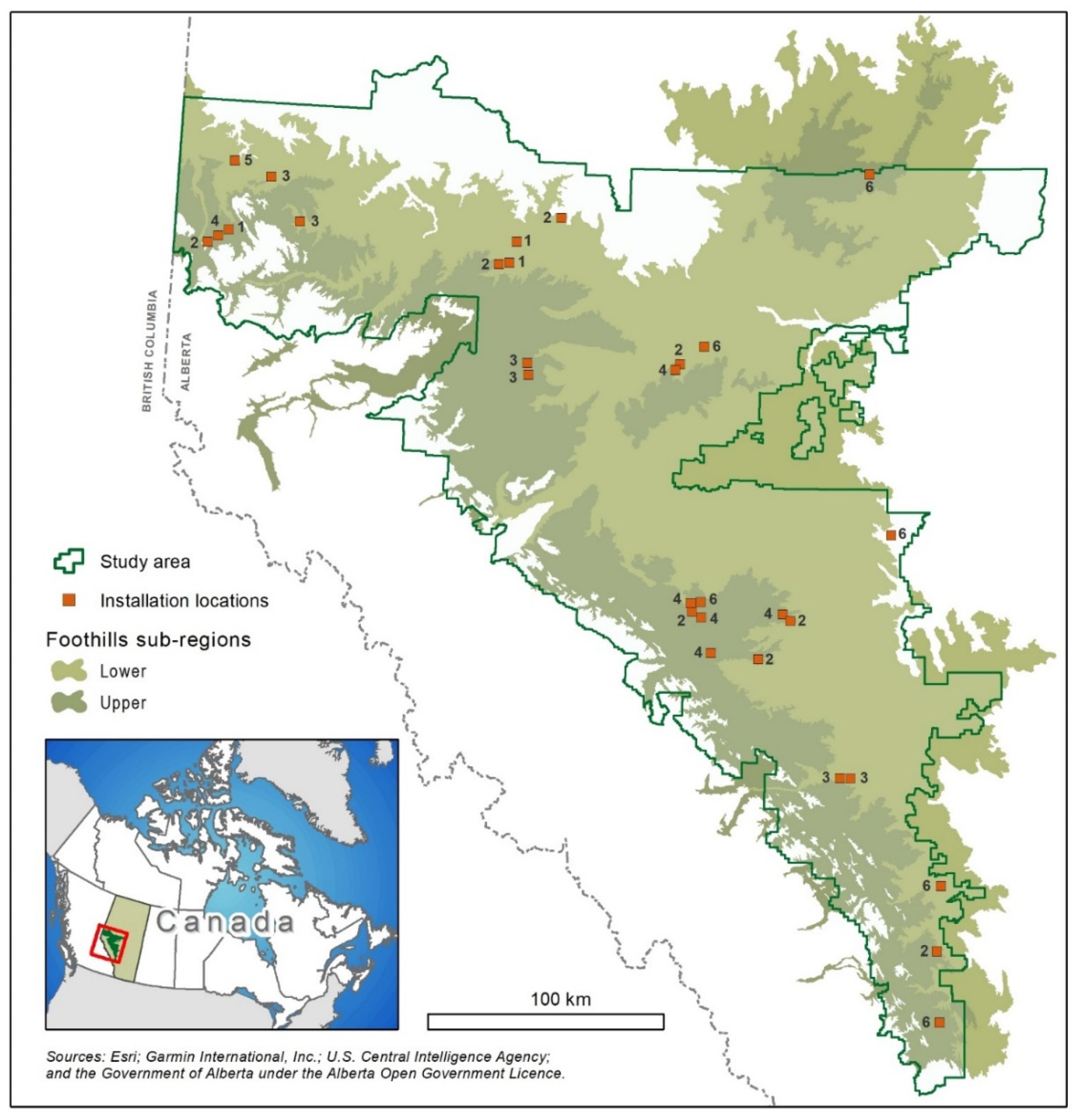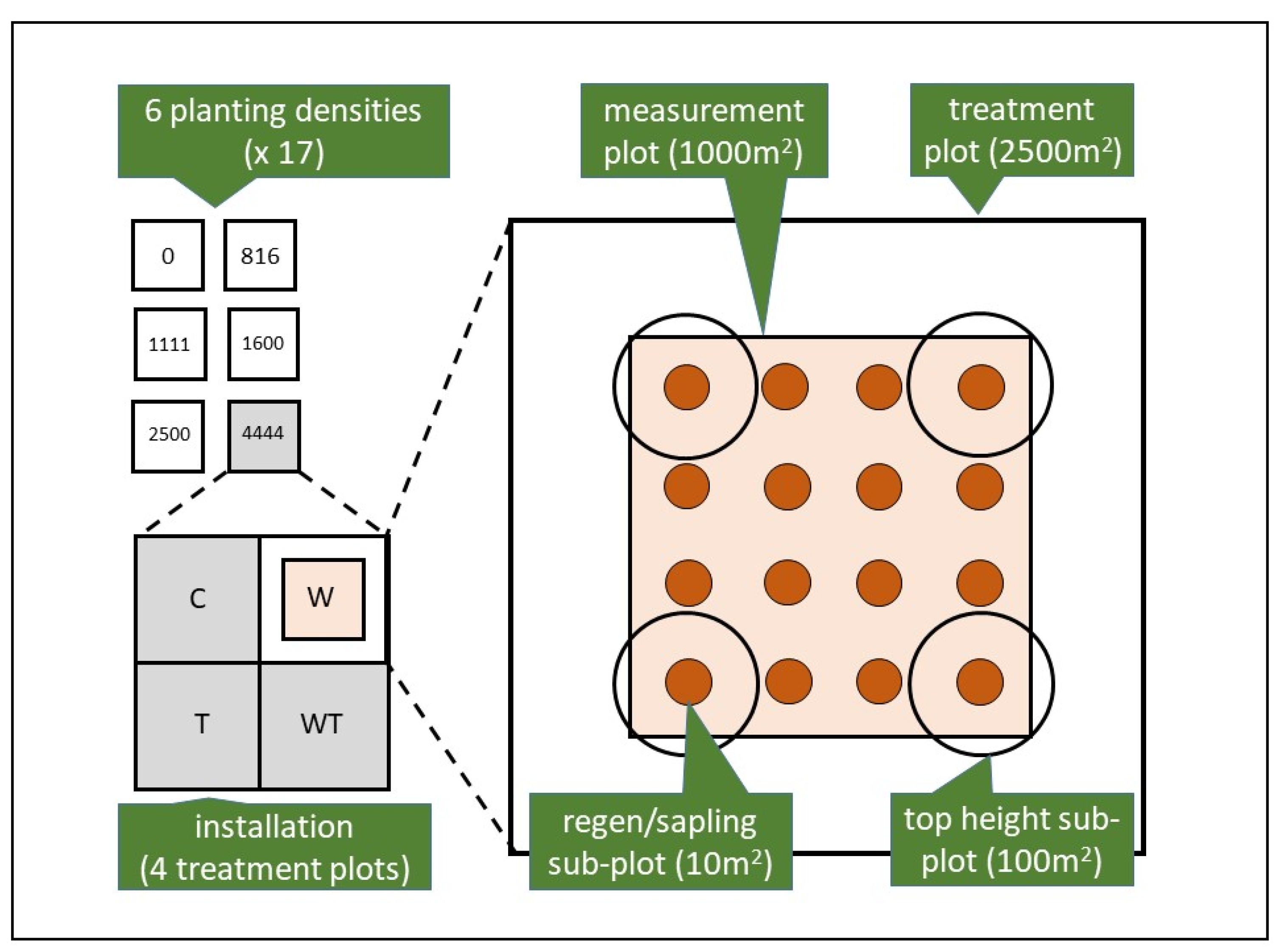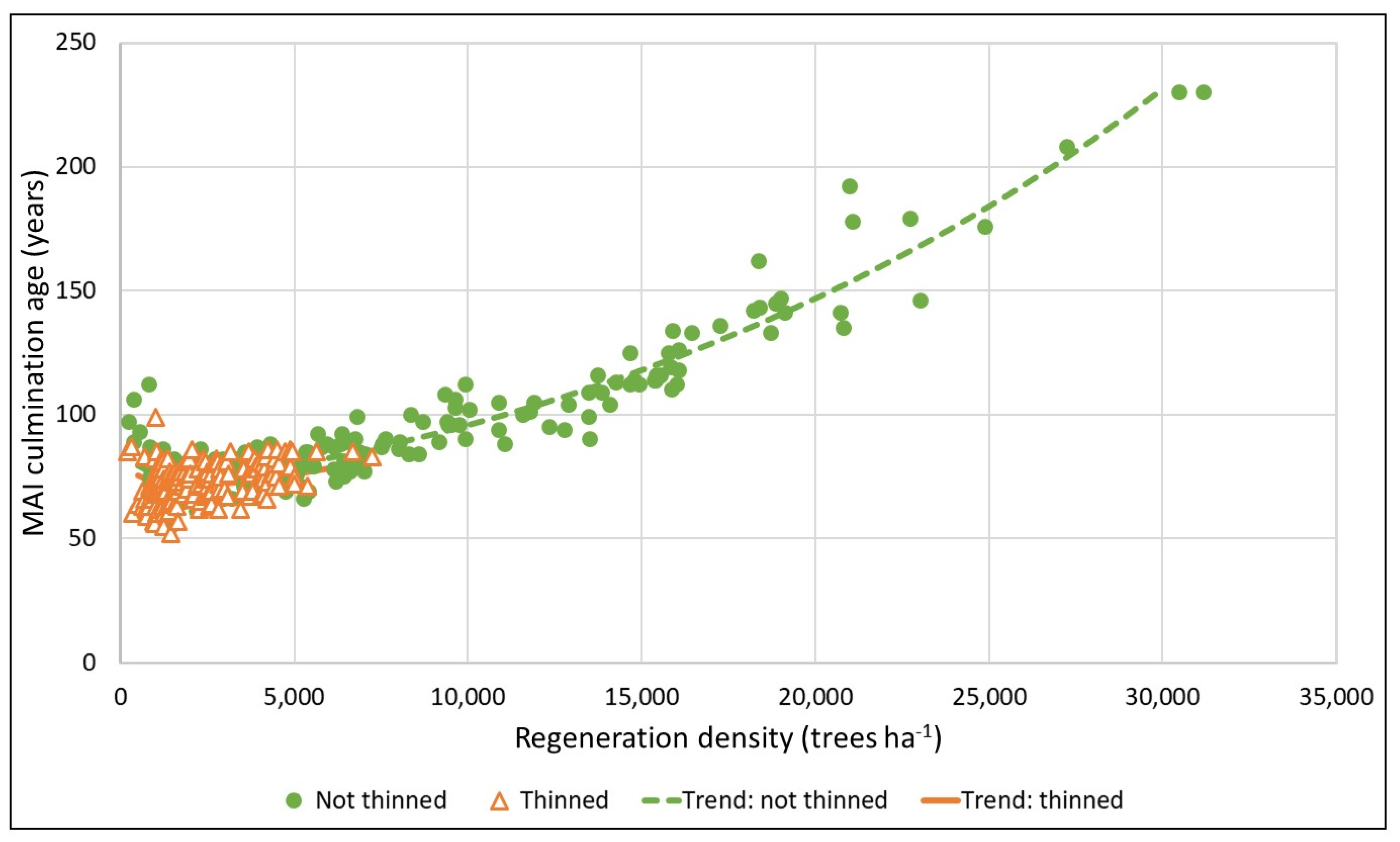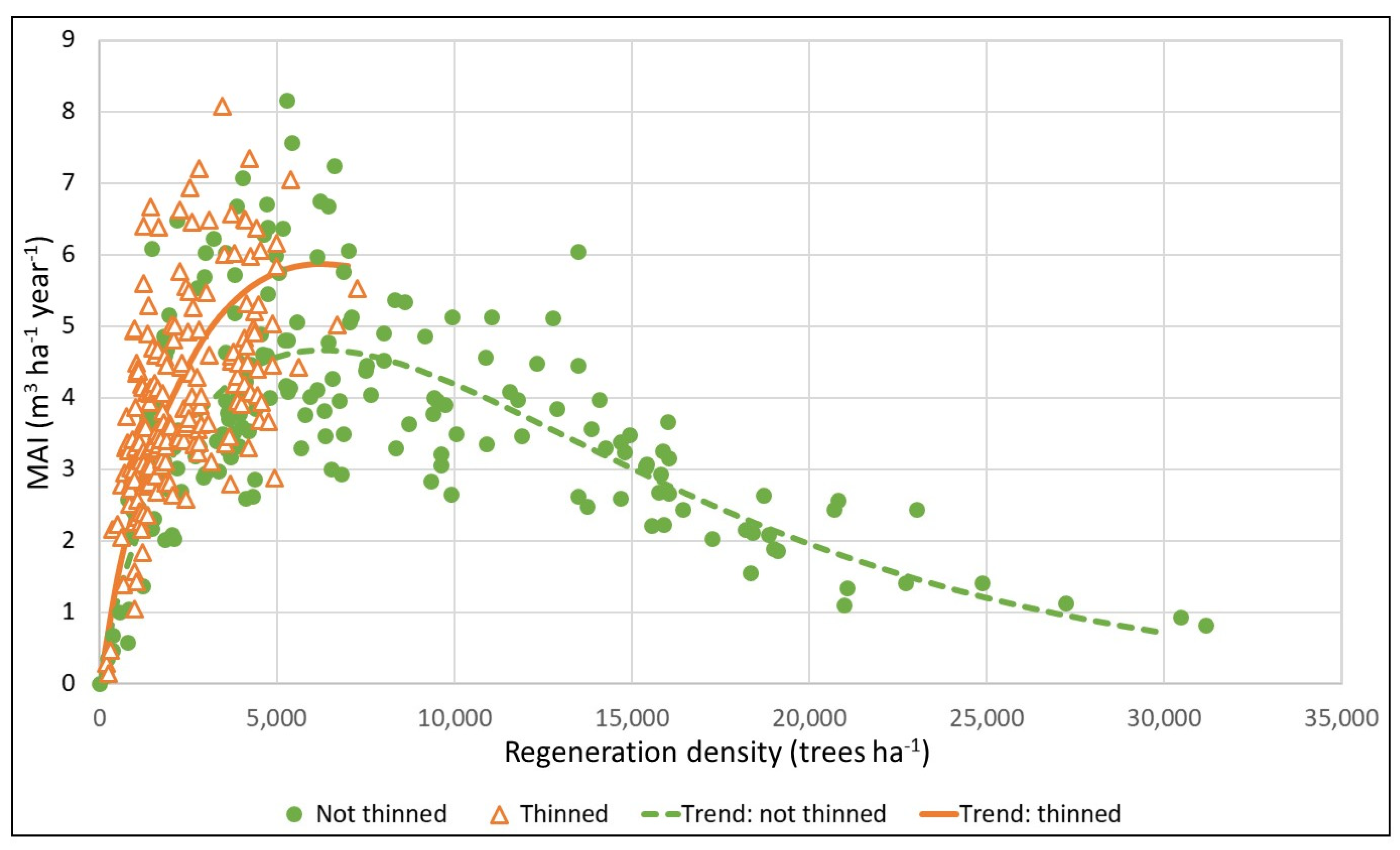Effects of Planting, Vegetation Management, and Pre-Commercial Thinning on the Growth and Yield of Lodgepole Pine Regenerated after Harvesting in Alberta, Canada
Abstract
:1. Introduction
- Planting (planting density, and planting versus natural regeneration);
- Early vegetation management (“weeding”) to control hardwood, shrub, and herbaceous competition;
- Pre-commercial thinning to remove the natural regeneration of trees surplus to the designated planting density.
2. Materials and Methods
- Age: average total age, in years since germination, of the 100 largest-diameter trees ha−1;
- Top height: average height of the 100 largest-diameter trees ha−1;
- % stocking: percentage of 10 m2 regeneration sub-plots occupied by at least one live tree ≥1.3 m in height;
- Density: number of live trees ha−1 ≥1.3 m in height;
- Basal area: total basal area ha−1 of live trees, measured at 1.3 m above ground level.
- Average height: average total height of all trees ≥1.3 m in height;
- Live crown ratio (LCR): average ratio of crown length to total height;
- Quadratic mean diameter breast-height (DBH): measured 1.3 m above ground level.
- Site index: top height at 50 years’ breast-height age;
- MAI: maximum gross merchantable mean annual volume increment;
- Culmination age: years after harvest at which merchantable MAI culminates (this is equated with rotation age in RSA yield projection system).
3. Results
3.1. Stand Conditions 17 Growing Seasons after Planting
3.2. Stand Dynamics 17 to 19 Growing Seasons after Planting
3.3. Impact of Uncontrolled Site and Stand Variables
3.4. Projected Growth and Yield
4. Discussion
5. Conclusions
- Planting is not always necessary to re-establish lodgepole pine in the Alberta foothills, and planted trees are often outnumbered by natural regeneration. However, it reduces the risk of regeneration failure and is essential to restocking pine on some sites. Timber production is expected to increase with planting density, even where natural regeneration is adequate to meet regulated reforestation standards.
- Herbicide application improves the stocking and growth of lodgepole pine where there is competing hardwood or herbaceous vegetation. It facilitates the regeneration of the species, which would otherwise be difficult or impossible, on sites where such competition is severe. Manual weeding and thinning of aspen are less likely to be effective.
- Pre-commercial thinning is expected to shorten lodgepole pine rotations and, when applied to dense stands where excessive natural regeneration has occurred, increase future merchantable timber yields based on current utilization standards. Risks and uncertainties, likely to be exacerbated by climate change, increase with thinning weight.
- Treatment responses vary greatly depending on environmental site factors. Planting, vegetation management, or thinning will each be necessary and justified in some situations but, depending on site conditions and management objectives, redundant or counterproductive in others.
Funding
Data Availability Statement
Acknowledgments
Conflicts of Interest
References
- Rowe, J.S. Forest Regions of Canada; Publication No. 1300; Dept. of Fisheries and the Environment, Canadian Forestry Service: Ottawa, ON, Canada, 1972; p. 172.
- Andison, D.W. Patterns of age-class distributions on foothills landscapes in Alberta. Ecography 1998, 21, 543–550. [Google Scholar] [CrossRef]
- Johnstone, W.D. Ingress of Lodgepole Pine and White Spruce Regeneration Following Logging and Scarification in West-Central Alberta; Information Rep. NOR-X-170; Environment Canada, Canadian Forest Service, Northern Forestry Research Centre: Edmonton, AB, Canada, 1976; p. 12.
- Landhäusser, S.M. Impact of slash removal, drag scarification and mounding on lodgepole pine cone distribution and seedling regeneration after cut-to-length harvesting on high elevation sites. Forest. Ecol. Manag. 2009, 258, 43–49. [Google Scholar] [CrossRef]
- Huang, S.; Monserud, R.A.; Braun, T.; Lougheed, H.; Bakowsky, O. Comparing site productivity of mature fire-origin and post-harvest juvenile lodgepole pine stands in Alberta. Can. J. For. Res. 2004, 34, 1181–1191. [Google Scholar] [CrossRef]
- Alberta Agriculture and Forestry. Reforestation Standard of Alberta; Department of Agriculture and Forestry, Forestry Division, Forest Stewardship and Trade Branch: Edmonton, AB, Canada, 2021; p. 361.
- Dempster, W.R.; Meredith, S. A discussion of best management practices for reforestation following harvesting of lodgepole pine in the Alberta Foothills. For. Chron. 2014, 90, 763–770. [Google Scholar] [CrossRef]
- Stewart, J.D.; Jones, T.N.; Noble, R.C. Long-Term Lodgepole Pine Silviculture Trials in Alberta: History and Current Results; Natural Resources Canada, Canadian Forest Service, Northern Forestry Centre: Edmonton, AB, Canada, 2006; p. 184.
- Wheeler, N.C.; Critchfield, W.B. The distribution and botanical characteristics of lodgepole pine: Biogeographical and management implications. In Lodgepole Pine: The Species and Its Management; Symposium Proceedings; Baumgartner, D.M., Krebill, R.G., Arnott, J.T., Weetman, G.F., Eds.; Washington State Univ.: Pullman, WA, USA, 1985; pp. 1–13. [Google Scholar]
- Lotan, J.; Brown, J.; Neuenschwander, L. Role of fire in lodgepole pine forests. In Lodgepole Pine: The Species and Its Management; Symposium Proceedings; Baumgartner, D.M., Krebill, R.G., Arnott, J.T., Weetman, G.F., Eds.; Washington State Univ.: Pullman, WA, USA, 1985; pp. 133–152. [Google Scholar]
- Goudie, J.W. The Effects of Density on the Growth and Development of Repressed Lodgepole Pine and Suppressed Inland Douglas Fir; final contract report on Project EP 850.02; BC Ministry of Forests, Res. Br.: Victoria, BC, Canada, 1980.
- Farnden, C.; Herring, L. Severely repressed lodgepole pine responds to thinning and fertilization: 19-year results. For. Chron. 2002, 78, 404–414. [Google Scholar] [CrossRef] [Green Version]
- Cerezke, H.F. Survival of the weevil Hylobius warreni in lodgepole pine stumps. Can. J. For. Res. 1973, 3, 367–372. [Google Scholar] [CrossRef]
- Wolken, J.M.; Blenis, P.V.; Duncan, I. Predicting survival of lodgepole pine stands infected with western gall rust. Can. J. For. Res. 2006, 36, 878–885. [Google Scholar] [CrossRef]
- Dempster, W.R. Impact of climate on juvenile mortality and Armillaria root disease in lodgepole pine. For. Chron. 2017, 93, 148–160. [Google Scholar] [CrossRef] [Green Version]
- Johnstone, W.D.; van Thienen, F.J. The Effects of Plantation Density on the Growth and Yield of Lodgepole Pine: 20-Year Results; Extension Note 102; B.C. Ministry of Forests and Range, Forest Science Program: Victoria, BC, Canada, 2011; p. 7. [Google Scholar]
- Harper, G.J.; Astridge, K.; de Montigny, L. Effects of High Plantation Densities on the Growth and Yield of Lodgepole Pine: 34-Year Results at Barnes Creek (ep770.55); Prov. B.C. Technical Report 115; B.C. Ministry of Forests and Range, Forest Science Program: Victoria, BC, Canada, 2018; p. 45. Available online: www.for.gov.bc.ca/hfd/pubs/Docs/Tr/Tr115.htm (accessed on 21 February 2022).
- Wagner, R.G.; Little, K.M.; Richardson, B.; McNabb, K. The role of vegetation management for enhancing productivity of the world’s forests. Forestry 2006, 79, 57–79. [Google Scholar] [CrossRef]
- Comeau, P.G.; Fraser, E.C. Plant community diversity and tree growth following single and repeated glyphosate herbicide applications to a white spruce plantation. Forests 2018, 9, 107. [Google Scholar] [CrossRef] [Green Version]
- Stewart, J.D.; Salvail, J.C. Evaluation of Precommercial Thinning of Lodgepole Pine from Long-Term Research Installations in Alberta; Canadian Wood Fibre Centre Information Report FI-X-16; Canadian Forest Service, Northern Forestry Centre: Edmonton, AB, Canada, 2017; p. 62.
- Johnstone, W.D. The effects of juvenile spacing on 7-year-old lodgepole pine in central British Columbia. West. J. Appl. For. 2005, 20, 160–166. [Google Scholar] [CrossRef]
- Lindgren, P.M.F.; Sullivan, T.P. Long-term responses of tree and stand growth of young lodgepole pine to pre-commercial thinning and repeated fertilization. Forest Ecol. Manag. 2013, 307, 155–164. [Google Scholar] [CrossRef]
- Hagner, S.O.A. Lodgepole pine management in Sweden: A strategy for higher yield. In Lodgepole Pine: The Species and Its Management; Symposium Proceedings; Baumgartner, D.M., Krebill, R.G., Arnott, J.T., Weetman, G.F., Eds.; Washington State Univ.: Pullman, WA, USA, 1985; pp. 211–217. [Google Scholar]
- Subramanian, N.; Bergh, J.; Johansson, U.; Nilsson, U.; Sallnäs, O. Adaptation of forest management regimes in southern Sweden to increased risks associated with climate change. Forests 2016, 7, 8. [Google Scholar] [CrossRef] [Green Version]
- Comeau, P.G.; Braumandl, T.F.; Chang-Yi, X. Effects of overtopping vegetation on light availability and growth of Engelmann spruce (Picea engelmannii) seedlings. Can. J. For. Res. 1993, 23, 2044–2048. [Google Scholar] [CrossRef]
- Archibald, J.H.; Klappstein, G.D.; Corns, I.G. Field Guide to Ecosites of Southwestern Alberta; Special Report 8; Canadian Forest Service, Northwest Region, Northern Forestry Centre: Edmonton, AB, Canada, 1996; p. 492.
- Beckingham, J.D.; Corns, I.G.; Archibald, J.H. Field Guide to Ecosites of West-Central Alberta; Special Report 9; Canadian Forest Service, Northwest Region, Northern Forestry Centre: Edmonton, AB, Canada, 1996; p. 540.
- Bokalo, M.; Stadt, K.J.; Comeau, P.G.; Titus, S.J. The validation of the Mixedwood Growth Model (MGM) for use in forest management decision making. Forests 2013, 4, 1–27. [Google Scholar] [CrossRef]
- Dempster, W.R.; Gulyas, G. Foothills Reforestation Interactive Planning System, User Guide; Forest Growth Organization of Western Canada: Hinton, AB, Canada, 2021; p. 53. Available online: https://fgrow.friresearch.ca/resource/foothills-reforestation-interactive-planning-system (accessed on 13 April 2022).
- Huang, S.; Meng, S.; Yang, Y. A Growth and Yield Projection System (GYPSY) for Natural and Post-Harvest Stands in Alberta; Technical Report Pub. No. T/216; Alberta Sustainable Resource Development: Edmonton, AB, Canada, 2009; p. 22. [Google Scholar]
- Anon. JMP Statistics and Graphics Guide; Version 5; SAS Institute Inc.: Cary, NC, USA, 2002; p. 707. [Google Scholar]
- Liziniewicz, M.; Eko, M.; Agestum. Effect of spacing on 23-year-old lodgepole pine (Pinus contorta Dougl. var. latifolia) in southern Sweden. Scand. J. For. Res. 2012, 27, 361–371. [Google Scholar] [CrossRef]
- Johnstone, W.D.; van Thienen, F.J. The Effects of Precommercial Thinning on the Growth and Yield of Lodgepole Pine, 25-Year Results; Exten. Note 103; B.C. Ministry of Forests and Range, Forest Science Program: Victoria, BC, Canada, 2011; p. 9. [Google Scholar]
- Johnstone, W.D. Thinning lodgepole pine. In Lodgepole Pine: The Species and Its Management; Symposium Proceedings; Baumgartner, D.M., Krebill, R.G., Arnott, J.T., Weetman, G.F., Eds.; Washington State Univ.: Pullman, WA, USA, 1985; pp. 253–262. [Google Scholar]
- Prescott, C.; de Montigny, L.; Harper, G.J. Eighteen-year growth responses to thinning and fertilization of a height-repressed lodgepole pine stand in interior British Columbia. For. Chron. 2019, 95, 207–221. [Google Scholar] [CrossRef] [Green Version]
- Ives, W.G.; Rentz, C.L. Factors Affecting the Survival of Immature Lodgepole Pine in the Foothills of West-Central Alberta; Forestry Canada Information Report NOR-X-330; Northern Forestry Centre: Edmonton, AB, Canada, 1993; p. 49.
- Ulvcrona, K.A.; Karlsson, L.; Backlund, I.; Bergsten, U. Comparison of silvicultural regimes of lodgepole pine (Pinus contorta) in Sweden 5 years after precommercial thinning. SilvaFennica 2013, 47, 974. [Google Scholar]




| Variable | Thinning | Planting (Trees ha−1) and Weeding (None, Weed) | |||||||||||
|---|---|---|---|---|---|---|---|---|---|---|---|---|---|
| 0 | 816 | 1111 | 1600 | 2500 | 4444 | ||||||||
| None | Weed | None | Weed | None | Weed | None | Weed | None | Weed | None | Weed | ||
| Age (years) | No thin | 15.7 | 16.3 | 18.2 | 18.2 | 18.2 | 18.2 | 18.2 | 18.2 | 18.2 | 18.2 | 18.2 | 18.2 |
| 2.7 | 1.6 | 0.5 | 0.5 | 0.5 | 0.5 | 0.5 | 0.5 | 0.5 | 0.5 | 0.5 | 0.5 | ||
| Thin | 15.8 | 16.5 | 18.2 | 18.2 | 18.2 | 18.2 | 18.2 | 18.2 | 18.2 | 18.2 | 18.2 | 18.2 | |
| 2.7 | 1.9 | 0.5 | 0.5 | 0.5 | 0.5 | 0.5 | 0.5 | 0.5 | 0.5 | 0.5 | 0.5 | ||
| Top ht. (cm) | No thin | 580 | 657 | 684 | 704 | 692 | 727 | 692 | 701 | 686 | 722 | 719 | 724 |
| 149 | 146 | 129 | 134 | 128 | 141 | 136 | 132 | 114 | 140 | 119 | 137 | ||
| Thin | 559 | 638 | 698 | 714 | 679 | 749 | 667 | 694 | 699 | 724 | 712 | 738 | |
| 155 | 149 | 98 | 116 | 130 | 123 | 123 | 139 | 109 | 137 | 107 | 133 | ||
| Avg. ht. (cm) | No thin | 370 | 445 | 430 | 459 | 427 | 479 | 439 | 458 | 425 | 474 | 502 | 519 |
| 75 | 123 | 109 | 137 | 108 | 113 | 164 | 161 | 113 | 153 | 114 | 142 | ||
| Thin | 409 | 479 | 531 | 581 | 515 | 622 | 525 | 579 | 547 | 573 | 543 | 587 | |
| 121 | 111 | 124 | 141 | 133 | 135 | 127 | 164 | 122 | 160 | 111 | 145 | ||
| Live crown ratio | No thin | 0.64 | 0.68 | 0.65 | 0.67 | 0.60 | 0.66 | 0.62 | 0.66 | 0.61 | 0.64 | 0.60 | 0.60 |
| 0.10 | 0.13 | 0.13 | 0.11 | 0.12 | 0.13 | 0.13 | 0.11 | 0.12 | 0.11 | 0.11 | 0.11 | ||
| Thin | 0.74 | 0.75 | 0.82 | 0.84 | 0.76 | 0.81 | 0.79 | 0.79 | 0.76 | 0.76 | 0.68 | 0.68 | |
| 0.06 | 0.07 | 0.08 | 0.08 | 0.11 | 0.07 | 0.10 | 0.11 | 0.08 | 0.09 | 0.11 | 0.11 | ||
| DBH (cm) | No thin | 4.16 | 5.38 | 5.51 | 6.16 | 5.41 | 6.26 | 5.33 | 5.92 | 5.22 | 6.05 | 6.10 | 6.38 |
| 0.86 | 1.87 | 2.35 | 2.48 | 1.93 | 1.78 | 2.35 | 2.92 | 1.50 | 2.16 | 1.42 | 1.68 | ||
| Thin | 5.32 | 6.34 | 9.20 | 9.98 | 8.72 | 10.36 | 8.14 | 9.01 | 8.07 | 8.26 | 7.31 | 7.73 | |
| 1.81 | 1.25 | 2.17 | 2.19 | 2.44 | 1.89 | 1.95 | 2.54 | 1.53 | 1.63 | 1.12 | 1.59 | ||
| % stocked | No thin | 75.4 | 83.3 | 87.9 | 84.8 | 79.3 | 93.0 | 90.6 | 96.5 | 91.4 | 96.9 | 96.5 | 99.2 |
| 34.4 | 28.1 | 17.1 | 18.8 | 25.1 | 9.6 | 17.7 | 6.4 | 19.1 | 4.6 | 7.6 | 3.1 | ||
| Thin | 80.4 | 81.7 | 69.5 | 76.2 | 80.5 | 88.7 | 90.6 | 91.8 | 95.3 | 97.3 | 98.4 | 98.4 | |
| 29.9 | 27.8 | 18.4 | 11.7 | 15.6 | 8.6 | 11.2 | 8.1 | 7.7 | 4.5 | 3.6 | 4.3 | ||
| Density (trees ha−1) | No thin | 7858 | 8621 | 7954 | 6770 | 6878 | 7150 | 8797 | 8945 | 6689 | 7660 | 6551 | 7194 |
| 6213 | 7679 | 6794 | 5808 | 8001 | 6045 | 8857 | 7915 | 5441 | 5908 | 4447 | 4075 | ||
| Thin | 3621 | 3517 | 906 | 962 | 1131 | 1239 | 1679 | 1718 | 2221 | 2486 | 3990 | 3828 | |
| 1824 | 1827 | 302 | 218 | 333 | 243 | 345 | 245 | 550 | 273 | 687 | 444 | ||
| Basal area (m2 ha−1) | No thin | 10.4 | 14.1 | 12.3 | 12.5 | 10.9 | 15.9 | 11.9 | 15.6 | 11.9 | 16.4 | 16.8 | 20.0 |
| 7.8 | 8.2 | 8.1 | 6.6 | 7.7 | 6.5 | 7.4 | 5.1 | 7.2 | 5.9 | 5.9 | 6.4 | ||
| Thin | 9.7 | 11.3 | 5.8 | 7.6 | 7.6 | 10.4 | 9.1 | 11.2 | 11.7 | 13.6 | 17.3 | 18.5 | |
| 6.1 | 6.6 | 2.6 | 3.2 | 4.8 | 3.2 | 4.9 | 5.7 | 5.2 | 5.0 | 6.3 | 7.0 | ||
| Effect | Age | Top Height | Average Height | LCR | DBH | % Stocked | Density | Basal Area |
|---|---|---|---|---|---|---|---|---|
| Planting | n/a | 0.0904 | 0.1691 | 0.0569 | 0.0015 | 0.0002 | 0.0003 | <0.0001 |
| Weeding | 0.0275 | <0.0001 | <0.0001 | 0.0015 | <0.0001 | 0.0003 | 0.0443 | <0.0001 |
| Thinning | 0.5311 | 0.8801 | <0.0001 | <0.0001 | <0.0001 | 0.0666 | <0.0001 | <0.0001 |
| Thin × Weed | 0.9183 | 0.4916 | 0.2021 | 0.0666 | 0.7299 | 0.3460 | 0.4580 | 0.1196 |
| Plant × Weed | n/a | 0.0408 | 0.2551 | 0.1153 | 0.2650 | 0.2000 | 0.7331 | 0.5685 |
| Plant × Thin | n/a | 0.7474 | 0.0044 | <0.0001 | <0.0001 | 0.0013 | <0.0001 | 0.0121 |
| Plant × Thin × Weed | n/a | 0.9103 | 0.6987 | 0.9034 | 0.6816 | 0.3586 | 0.8200 | 0.8292 |
| Variable | No Weeding | Weeding | ||
|---|---|---|---|---|
| No Thin | Thin | No Thin | Thin | |
| (C) | (T) | (W) | (WT) | |
| Top height (cm) | 46.5 | 46.7 | 47.7 | 48.8 |
| 15.7 | 15.3 | 18.6 | 15.4 | |
| Average height (cm) | 32.2 | 33.3 | 37.6 | 39.9 |
| 17.3 | 17.6 | 20.1 | 16.8 | |
| Live crown ratio | −0.04 | −0.02 | −0.04 | −0.02 |
| 0.03 | 0.03 | 0.03 | 0.02 | |
| DBH (cm) | 0.35 | 0.52 | 0.40 | 0.53 |
| 0.19 | 0.20 | 0.19 | 0.17 | |
| Density (trees ha−1) | −100 | 29 | −160 | 7 |
| 579 | 134 | 777 | 131 | |
| Basal area (m2 ha−1) | 1.40 | 1.29 | 1.66 | 1.40 |
| 0.87 | 0.69 | 0.86 | 0.71 | |
| Response Variable | Categorical Covariates | Continuous Covariates | ||||||
|---|---|---|---|---|---|---|---|---|
| Prep | SNC | SMC | NSR | Elev | Lat | LFH | Cones | |
| Age | 0.0425 | 0.2873 | 0.7929 | 0.6818 | 0.9414 | 0.0061 | 0.9414 | 0.4459 |
| D> M,N | − | |||||||
| Top height | 0.0013 | <0.0001 | 0.006 | 0.6398 | 0.0083 | 0.9334 | 0.3084 | 0.0413 |
| M> N > D | D> C > B | M> H | − | − | ||||
| Avg. height | <0.0001 | <0.0001 | 0.0598 | 0.4936 | 0.0129 | 0.1309 | 0.6761 | 0.0045 |
| M> N,D | D> C > B | − | − | |||||
| Live crown ratio | 0.3918 | <0.0001 | 0.0599 | 0.0897 | 0.0086 | 0.1418 | 0.0054 | 0.8085 |
| B> C,D | + | + | ||||||
| DBH | <0.0001 | <0.0001 | 0.4697 | 0.0440 | 0.1519 | 0.0364 | 0.5032 | 0.0012 |
| M> D > N | D> C > B | U> L | + | − | ||||
| % stocked | 0.0007 | 0.0005 | 0.3829 | 0.2231 | 0.0072 | 0.0390 | 0.0125 | 0.0716 |
| D> M,N | C,B> D | + | − | − | ||||
| Density | <0.0001 | <0.0001 | 0.1016 | 0.1008 | <0.0001 | <0.0001 | 0.0024 | <0.0001 |
| D> M,N | C> B > D | + | − | − | + | |||
| Basal area | 0.2954 | <0.0001 | 0.0126 | 0.0003 | 0.0016 | 0.0873 | 0.0024 | 0.3135 |
| D,C> B | M,X> H | U> L | + | − | ||||
| Variable | Thinning | Planting (Trees ha−1) and Weeding (None, Weed) | |||||||||||
|---|---|---|---|---|---|---|---|---|---|---|---|---|---|
| 0 | 816 | 1111 | 1600 | 2500 | 4444 | ||||||||
| None | Weed | None | Weed | None | Weed | None | Weed | None | Weed | None | Weed | ||
| Site index (m @ 50 years BH age) | No thin | 20.0 | 20.9 | 19.7 | 20.2 | 19.8 | 20.4 | 19.9 | 20.0 | 19.7 | 20.4 | 20.3 | 20.4 |
| 1.8 | 2.8 | 2.6 | 2.4 | 2.5 | 2.5 | 2.6 | 2.4 | 2.2 | 2.5 | 2.3 | 2.4 | ||
| Thin | 19.3 | 20.3 | 20.1 | 20.4 | 19.7 | 20.9 | 19.3 | 19.9 | 20.0 | 20.4 | 20.2 | 20.6 | |
| 2.3 | 2.7 | 2.1 | 2.2 | 2.5 | 2.3 | 2.5 | 2.4 | 2.1 | 2.5 | 2.0 | 2.3 | ||
| MAI (m3 ha−1 yr−1) | No thin | 2.78 | 3.76 | 3.05 | 3.64 | 2.82 | 4.10 | 2.97 | 4.01 | 3.21 | 4.28 | 4.33 | 4.94 |
| 1.36 | 2.02 | 1.02 | 1.16 | 1.66 | 1.52 | 1.02 | 1.48 | 1.36 | 1.63 | 1.22 | 1.54 | ||
| Thin | 3.51 | 4.09 | 2.89 | 3.25 | 3.11 | 3.96 | 3.60 | 4.14 | 4.04 | 4.66 | 4.80 | 5.31 | |
| 1.60 | 1.62 | 0.54 | 0.77 | 1.33 | 0.78 | 1.13 | 0.99 | 1.20 | 1.27 | 1.29 | 1.35 | ||
| MAI culmination age (years) | No thin | 100 | 99 | 97 | 90 | 100 | 89 | 102 | 100 | 92 | 90 | 85 | 85 |
| 17 | 35 | 31 | 24 | 36 | 25 | 41 | 45 | 20 | 25 | 17 | 18 | ||
| Thin | 86 | 80 | 69 | 68 | 72 | 67 | 73 | 70 | 73 | 72 | 76 | 74 | |
| 15 | 7 | 7 | 6 | 8 | 6 | 7 | 7 | 6 | 6 | 6 | 6 | ||
| Effect | Site Index | MAI | Culm. Age |
|---|---|---|---|
| Plant | 0.9801 | 0.0002 | 0.3436 |
| Weed | <0.0001 | <0.0001 | 0.0568 |
| Thin | 0.8135 | 0.0052 | <0.0001 |
| Thin × Weed | 0.5085 | 0.0847 | 0.8047 |
| Plant × Weed | 0.4208 | 0.6244 | 0.8617 |
| Plant × Thin | 0.2943 | 0.1290 | 0.0220 |
| Plant × Thin × Weed | 0.8873 | 0.9935 | 0.9168 |
Publisher’s Note: MDPI stays neutral with regard to jurisdictional claims in published maps and institutional affiliations. |
© 2022 by the author. Licensee MDPI, Basel, Switzerland. This article is an open access article distributed under the terms and conditions of the Creative Commons Attribution (CC BY) license (https://creativecommons.org/licenses/by/4.0/).
Share and Cite
Dempster, W.R. Effects of Planting, Vegetation Management, and Pre-Commercial Thinning on the Growth and Yield of Lodgepole Pine Regenerated after Harvesting in Alberta, Canada. Forests 2022, 13, 929. https://doi.org/10.3390/f13060929
Dempster WR. Effects of Planting, Vegetation Management, and Pre-Commercial Thinning on the Growth and Yield of Lodgepole Pine Regenerated after Harvesting in Alberta, Canada. Forests. 2022; 13(6):929. https://doi.org/10.3390/f13060929
Chicago/Turabian StyleDempster, W. Richard. 2022. "Effects of Planting, Vegetation Management, and Pre-Commercial Thinning on the Growth and Yield of Lodgepole Pine Regenerated after Harvesting in Alberta, Canada" Forests 13, no. 6: 929. https://doi.org/10.3390/f13060929
APA StyleDempster, W. R. (2022). Effects of Planting, Vegetation Management, and Pre-Commercial Thinning on the Growth and Yield of Lodgepole Pine Regenerated after Harvesting in Alberta, Canada. Forests, 13(6), 929. https://doi.org/10.3390/f13060929





